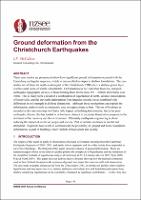Is the bar too high? Foundation settlement in post-earthquake Christchurch
Abstract
Three case studies are presented to show how significant ground deformation occurred with the Canterbury earthquake sequence, which in turn resulted in slopes to shallow foundations. The case studies are all from the north-western part of the Christchurch CDB where a shallow gravel layer overlies sand, some of which is liquefiable. Deformations as derived either from pre- and post-earthquake topographic surveys or from building floor levels show 250 – 300mm differential over 100m. This is likely to be a result of a combination of liquefaction at depth, seismic consolidation of looser soils, and the inevitable deformation from irregular seismic waves combined with differences in soil strength in all three dimensions. Although these mechanisms can explain the deformation, analysis tools are approximate at best. The out of levelness as recorded at the case sites may well have little impact on building functionality, but in the post-earthquake climate, this has tended to be lost in an attempt to maximise financial recompense to the detriment of the recovery and the environment. Ultimately earthquake engineering is about reducing the impact of events on people and society. Part of societal resilience is mental and attitudinal. Engineers have a role to communicate the possibility of ground and hence foundation deformation, as part of building a more resilient infrastructure and society.

